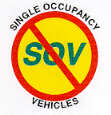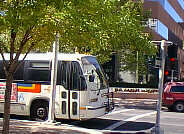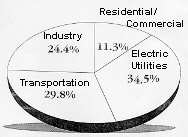 Albuquerque's Environmental Story
Albuquerque's Environmental Story
Educating For a Sustainable Community
Environmental Topic: Air Quality
by Alana Eager
The quality of Albuquerque's air depends on the
weather and personal lifestyle choices made by local residents. Geography is also
a factor. Our high altitude and valley location make Albuquerque a particularly
sensitive area.
At our mile-high elevation, atmospheric oxygen is 17% less than it is at sea
level. This condition causes increased carbon monoxide (CO) pollution from vehicles
and other burning activities because of incomplete and less effective combustion.
Winter Inversions Common
Our valley location and weather work together to create temperature inversions
during the colder months of the year. During calm periods, an upper layer of
warm air traps a layer of cooler, stagnant air along the surface of the land.
Air pollution trapped in the bottom layer of this inversion may reach critical
levels before a strong enough wind comes in to mix the air and disperse the
pollution.
More People, More Cars
More than one third of New Mexico's population lives in metropolitan Albuquerque.
Consequently Albuquerque is subject to the effects of growth and the environmental
stresses of larger cities. Since the mid-1970s, the Albuquerque urban area has
grown by more than 25 percent--from about 427,000 to 537,500. Projections for
the year 2015 put Albuquerque's population at 638,000; an average increase of
5,000 per year.
With increased population come more motor vehicles, new development and housing,
new employment, and more, often longer, commutes to work.
Programs Aimed at Improving Air Quality
 Albuquerque/Bernalillo
County has been classified as a nonattainment area for carbon monoxide by the
U.S. Environmental Protection Agency since 1978. In 1983, the area experienced
74 violations of the National Ambient Air Quality Standard (NAAQS) for CO. Control
measures, such as the vehicle emissions testing and oxygenated fuels programs,
and the wintertime NO-BURN program, were instituted to help decrease the amount
of CO pollution and reduce the number of violation of the NAAQS. The federal
Motor Vehicle Control Program, which requires improved emissions standards for
new cars, has also been a major factor. Since 1992 no violations of standards
have occurred (as of 1995), and the city is looking forward to redesignation
to an attainment area under a maintenance plan. Such a maintenance plan would
remain in effect for at least 20 years. The air quality programs currently in
place would remain.
Albuquerque/Bernalillo
County has been classified as a nonattainment area for carbon monoxide by the
U.S. Environmental Protection Agency since 1978. In 1983, the area experienced
74 violations of the National Ambient Air Quality Standard (NAAQS) for CO. Control
measures, such as the vehicle emissions testing and oxygenated fuels programs,
and the wintertime NO-BURN program, were instituted to help decrease the amount
of CO pollution and reduce the number of violation of the NAAQS. The federal
Motor Vehicle Control Program, which requires improved emissions standards for
new cars, has also been a major factor. Since 1992 no violations of standards
have occurred (as of 1995), and the city is looking forward to redesignation
to an attainment area under a maintenance plan. Such a maintenance plan would
remain in effect for at least 20 years. The air quality programs currently in
place would remain.
Efforts have also been directed towards encouraging the use of alternative
transportation to reduce the number of vehicles on the road. Walking, bicycling,
carpooling, transit ridership and employer-based incentive programs are recommended
in Albuquerque's metropolitan transportation plan Travel-Demand Management strategies
(TDMs) to minimize single-occupant vehicle (SOV) use and move people more efficiently
and effectively reduce vehicle emissions.
The Clean Air Act Amendments of 1990* and the Intermodal Surface Transportation
Efficiency Act of 1991 clearly support multiple modes of transportation to efficiently
move people and goods on the existing roadway system. These complementary pieces
of federal legislation acknowledge that we need more than just roadways as part
of an effective and efficient national transportation system to address mobility,
economics, energy conservation, and air pollution concerns.
 In
order for Albuquerque to be a clean air city, we need to make good land-use,
transportation, and air-quality decisions in concert. To cut down on transportation-related
air pollution, we must reduce the emissions of individual vehicles and reduce
the sheer number of vehicles congesting our roadways through travel-demand management
strategies, and land-use planning that facilitates pedestrian and other options
to one-passenger-vehicle trips.
In
order for Albuquerque to be a clean air city, we need to make good land-use,
transportation, and air-quality decisions in concert. To cut down on transportation-related
air pollution, we must reduce the emissions of individual vehicles and reduce
the sheer number of vehicles congesting our roadways through travel-demand management
strategies, and land-use planning that facilitates pedestrian and other options
to one-passenger-vehicle trips.
Because of our dry climate, dusty roads as well as woodburning activities are
the primary source of visibility degradation. The dry conditions result in poor
soil stabilization, thereby increasing dust from agriculture, construction activities
and roads, and contributing to high levels of dust particles (particulate matter)
in the air. These conditions can also clog air filters in vehicles, reducing
the air flow to the carburetor. This results in less efficient fuel burning
and increased emissions. Wood and open burning activities also contribute to
carbon monoxide pollution. But motor vehicles have been, and continue to be
the major source of CO.
Woodburning has been an important contributor to the visible wintertime "brown
cloud." A NO-BURN program that runs from October through February was initiated
in 1985 on a voluntary basis and became an important element of the Albuquerque/Bernalillo
County Air Quality Control Program for CO abatement in 1988. That program has
resulted in improved visibility as well as to the reduction in monitored CO
levels in recent years.
According to studies by Sandia National Laboratories, woodburning has been
an important contributor to this problem on winter nights. The NO-BURN program
has resulted in improved visibility on calm winter nights and mornings. It has
also contributed to the reduction in monitored CO levels in recent years.
Neighboring Sandoval and Valencia Counties have also instituted voluntary NO-BURN
programs to improve the overall air-shed. Other, industrial and area, sources
play a much smaller role with regard to CO.
- *1963 - Initial Clean Air Act - administered through the Department of
Health Education and Welfare, provided an opportunity for State and local
governments to join the Federal government in a national attack on air pollution
- 1967 - Air Quality Act - called for systematic, regional efforts to combat
air pollution.
- 1970 - Administered by the newly formed U.S. Environmental Protection
Agency (EPA) - Amendments established National Ambient Air Quality Standards
(NAAQS) for criteria pollutants, enforcement authority through State Implementation
Plans (SIPs), Air Quality Control Regions, New Source Performance Standards,
National Emissions Standards for Hazardous Air Pollutants, and carbon monoxide,
oxides of nitrogen, and hydrocarbon reduction goals for automobile manufacturers.
- 1977 - Amendments established EPA guidelines for state and local governments
in standardizing procedures and methods for Ambient Air Monitoring for criteria
pollutants with NAAQS, quality assurance requirements, attainment and nonattainment
area designations, prevention of significant deterioration criteria, new source
reviews, new source performance standards, best available control technology
programs, and addressed transportation control measures.
- 1990 - Amendments reclassified nonattainment areas according to the severity
of air pollution problems, further addressed mobile sources, and addressed
air toxicities, acid rain, alternative fuels, stratospheric ozone depletion,
and stationary source permitting.
Sources of Carbon Dioxide Emissions
 Electric utilities are the biggest source of carbon dioxide emissions in the
U.S. California and other states are trying to curb carbon dioxide emissions
by encouraging conservation and incorporating environmental costs into utility
rates. NOTE: Figures are for 1988. Source: Energy Information Administration.
Electric utilities are the biggest source of carbon dioxide emissions in the
U.S. California and other states are trying to curb carbon dioxide emissions
by encouraging conservation and incorporating environmental costs into utility
rates. NOTE: Figures are for 1988. Source: Energy Information Administration.
Options and Opinions
Discussion Questions
- Should a high priority be given to funding an improved public transportation
system?
- To what extent do the people of Albuquerque consider cleaner air an important
goal?
- What should be done about diesel emissions?
- How well could more coordinated land-use/transportation planning help minimize
air pollution?
Possible Solutions/Opinions
- The health effects of air pollution should be considered more important
than economic or convenience factors.
- Cars are the most convenient form of transportation, and people do not want
to cut back on their use, so we should build more roads to accommodate them.
- Albuquerque should adopt a system similar to the one used so successfully
in Portland, Oregon.
- Since there is so much concern about depletion of the ozone layer in the
earth's atmosphere, regulations against ozone as a pollutant should be removed.
Activities
- At a traffic light on a main arterial at rush hour, count the number of
cars with only one occupant. How many cars could one bus replace? Find out
what the predominant automobile air pollution emissions are. How much carbon
monoxide does an average bus emit? How much does an average automibile emit?
What factors influence this figure? How would the per capita carbon monoxide
emission of a filled bus and a one-passenger car idling at a red light compare?
- Set up a calendar for one month on which you can record information about
air pollution and the weather. At the same time each day, look toward the
mountains. Notice how well or how poorly you can see them. Keep a record of
the visibility, precipitation, temperature, wind direction, and velocity.
Call 766-SMOG and record the readings for carbon monoxide (CO), smog, and
dust. Prepare charts and graphs relating weather conditions to CO levels for
each day. Discuss any patterns noted.
- Find out from the Environmental Health Department which parts of the city
usually have the highest carbon monoxidelevels. Obtain a traffic flow chart.
Compare the information derived from both sources. What is the major source
o f CO pollution in the city in the daytime? On an average throughout the
year?
- Conduct a survey by having students prepare a questionnaire about fireplaces
and wood stoves. Then analyze responses and discuss their significance. Here
are some sample questions:
- Do you have a fireplace? A wood stove?
- Is there a grate holding the logs? Is there a space between the grate
and the old ashes?
- Is the fire lazy or active?
- Does the type of fire and burning change depending on the weather and
the type of wood?
- If you have a wood stove, does it have internal baffle plates, ducted
air supply, and firebox insulation?
- Keep a newspaper clipping file on Albuquerque's air quality and efforts
to improve it.
- Conduct a "Town Meeting" in the class on the subject of alternatives to
single-occupancy vehicles (SOVs). Discuss possible incentives and disincentives.
- Demonstrate thermal inversion.
- Most air pollution from burning is the result of incomplete combustion.
Demonstrate by placing a few wood shavings in a pie tin and igniting them.
Cover the burning shavings with a damp paper towel. The fire will begin to
smoke because it is not receiving enough oxygen to burn completely. Carbon
particles in the form of soot and CO are given off. Complete combustion would
oxidize these substances to carbon dioxide.
Shorthand Symbols for Recording Weather Observations and Air Quality Readings
- Visibility
sunny (SY)
partly cloudy (PC)
cloudy (CDY)
- Precipitation
clear (CLR)
rain (R)
snow (SN)
- Wind Speed
record in miles per hour
- Temperature
record in degreesof Celsius (C) or Farenheit (F)
- Wind Direction
north (N)
south (S)
east (E)
west (W)
- Air Quality Readings
record the Pollution Standards Index (PSI) for carbon monoxide (CO), dust
(D), and smog (SMG)
(Up to Section V, Back to Introduction,
On to Animal Control)
Copyright © 2008, Friends of Albuquerque's Environmental Story
 Albuquerque/Bernalillo
County has been classified as a nonattainment area for carbon monoxide by the
U.S. Environmental Protection Agency since 1978. In 1983, the area experienced
74 violations of the National Ambient Air Quality Standard (NAAQS) for CO. Control
measures, such as the vehicle emissions testing and oxygenated fuels programs,
and the wintertime NO-BURN program, were instituted to help decrease the amount
of CO pollution and reduce the number of violation of the NAAQS. The federal
Motor Vehicle Control Program, which requires improved emissions standards for
new cars, has also been a major factor. Since 1992 no violations of standards
have occurred (as of 1995), and the city is looking forward to redesignation
to an attainment area under a maintenance plan. Such a maintenance plan would
remain in effect for at least 20 years. The air quality programs currently in
place would remain.
Albuquerque/Bernalillo
County has been classified as a nonattainment area for carbon monoxide by the
U.S. Environmental Protection Agency since 1978. In 1983, the area experienced
74 violations of the National Ambient Air Quality Standard (NAAQS) for CO. Control
measures, such as the vehicle emissions testing and oxygenated fuels programs,
and the wintertime NO-BURN program, were instituted to help decrease the amount
of CO pollution and reduce the number of violation of the NAAQS. The federal
Motor Vehicle Control Program, which requires improved emissions standards for
new cars, has also been a major factor. Since 1992 no violations of standards
have occurred (as of 1995), and the city is looking forward to redesignation
to an attainment area under a maintenance plan. Such a maintenance plan would
remain in effect for at least 20 years. The air quality programs currently in
place would remain. In
order for Albuquerque to be a clean air city, we need to make good land-use,
transportation, and air-quality decisions in concert. To cut down on transportation-related
air pollution, we must reduce the emissions of individual vehicles and reduce
the sheer number of vehicles congesting our roadways through travel-demand management
strategies, and land-use planning that facilitates pedestrian and other options
to one-passenger-vehicle trips.
In
order for Albuquerque to be a clean air city, we need to make good land-use,
transportation, and air-quality decisions in concert. To cut down on transportation-related
air pollution, we must reduce the emissions of individual vehicles and reduce
the sheer number of vehicles congesting our roadways through travel-demand management
strategies, and land-use planning that facilitates pedestrian and other options
to one-passenger-vehicle trips. Electric utilities are the biggest source of carbon dioxide emissions in the
U.S. California and other states are trying to curb carbon dioxide emissions
by encouraging conservation and incorporating environmental costs into utility
rates. NOTE: Figures are for 1988. Source: Energy Information Administration.
Electric utilities are the biggest source of carbon dioxide emissions in the
U.S. California and other states are trying to curb carbon dioxide emissions
by encouraging conservation and incorporating environmental costs into utility
rates. NOTE: Figures are for 1988. Source: Energy Information Administration.